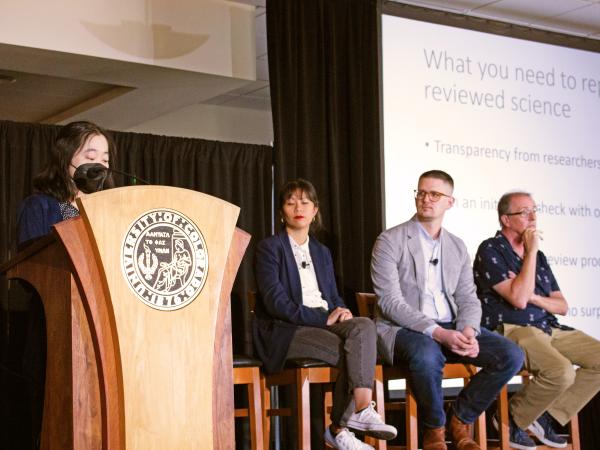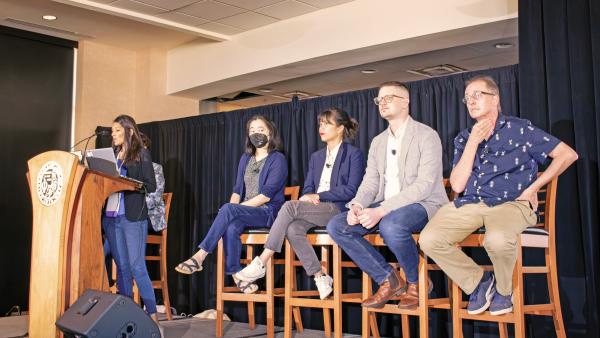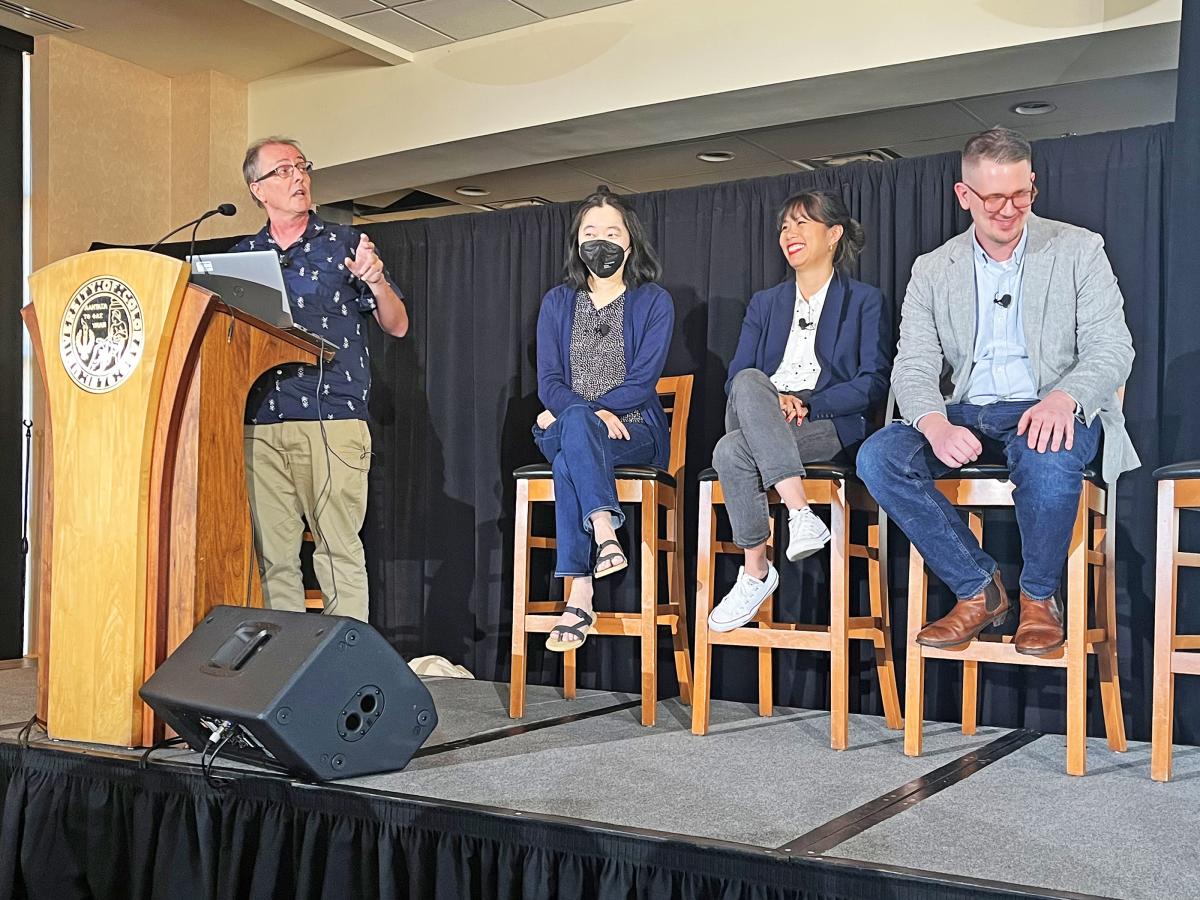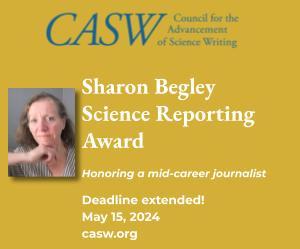Story by Alex (Ching Lam) Ip
Photography by Alex Ip and Gabriella Lewis
Interested in diving into complex, investigative stories? Peter Aldhous has bad news for you.
While a staff reporter for New Scientist, Aldhous looked into the Health Genetic Center (HGC). This Canadian paternity testing company shattered families by providing scientifically flawed and incorrect results. However, shortly after his article was published in December 2010, Yuri Melekhovets, HGC’s CEO, sued for libel. The situation devolved into a legal battle that mercifully concluded in April 2020 with judges turning back HGC not just once, but three times.
Aldhous’ case is an outlier. However, it is still important for science writers, especially early-career journalists and freelancers, to be prepared for the curveballs thrown their way. This can be done by bulletproofing their reporting, treating their sources with respect, and reading the fine print.
During the “Data, FOIAs, Tips: Pursuing Investigative Stories as a Science Writer” (#InvestigativeSciWri) workshop at ScienceWriters2023 in Boulder, panelists took turns walking attendees through their most noteworthy investigations. The session was organized by NASW member volunteers Betsy Ladyzhets of the COVID-19 Data Dispatch and Priyanka Runwal of C&EN.
To start off, Lisa Song, a Pulitzer-winning environment, energy, and climate reporter at ProPublica, explained how to deal with the mushrooming body of non-peer-reviewed research, especially after the start of the COVID-19 pandemic. After gaining exclusive access from a trusted research source that dissected California’s carbon offset program, Song and her colleagues at ProPublica and MIT Technology Review vetted the methodology and research findings by sending the paper under embargo to four outside scientists.
Adhering to a “no-surprises” policy, throughout the months of reporting, Song’s team had also been talking continuously with California regulators and the various companies named in their story that sell and deal with carbon offsets.
 Panelist Lisa Song speaks at the #InvestigativeSciWri workshop at ScienceWriters2023 in Boulder. (Alex Ip for NASW)
Panelist Lisa Song speaks at the #InvestigativeSciWri workshop at ScienceWriters2023 in Boulder. (Alex Ip for NASW)
“Once we had a final version of the paper and we had done our peer review process, we ended up giving the targets of our story between two and a half to three weeks to read the paper and respond to it. We wanted to give them enough time so that it was fair and that they were able to digest and respond to a complex paper. But we were also a little bit afraid if we gave them too much time, they might be tempted to leak the study to other reporters in an effort to kind of scoop our reporting,” she said
Luckily for Song, that didn’t happen. The targets of the investigation provided extensive comments on the paper, which they included in their final story, “The Climate Solution Actually Adding Millions of Tons of CO2 Into the Atmosphere,” along with supplementary materials. Building upon that work, Song embarked on a reporting trip to Guinea in West Africa to look at how a mining company used dubious biodiversity offsets brokered by the World Bank Group to justify the destruction of local villages and chimpanzee habitats.
Next up was Stephanie Lee, a senior reporter at The Chronicle of Higher Education who specializes in reporting on scientific misconduct. While she was writing for Buzzfeed News, she had to exercise her creativity while looking into the simmering academic concerns about celebrity researcher Dr. Brian Wansink. He was then living the best of both worlds: a professor of marketing at the Cornell University Food and Brand Lab, while making appearances on Good Morning America and the TODAY show.
Cornell is a private university, which is usually not subject to public record requests; however, Lee had a workaround by making a spreadsheet with all the problematic studies that Dr. Wansink co-authored, highlighting all his collaborators who were at public universities — which must respond to public record requests — and then sending highly specific requests to those authors asking for correspondence between them and the Cornell lab. Soon enough, emails of Dr. Wansink bragging about his manipulation of data started flooding in. But that was just the beginning of her work.
“You almost definitely don’t want to just dump a series of PDFs online because you are not WikiLeaks,” explained Lee. Like Song, Lee reached out to independent statisticians to review the emails, which helped her identify more previously unreported problematic research papers. By the time “Here's How Cornell Scientist Brian Wansink Turned Shoddy Data Into Viral Studies About How We Eat” went public, Cornell reopened an investigation and Dr. Wansink was forced to retire. Today, he counts 18 retractions, 18 corrections, and seven expressions of concern to his name.
Nicholas Florko, who investigates how business decisions impact health for STAT, followed up with how he used public record documents, court filings, and a hard-to-obtain dataset to show how state prisons were failing to test and treat incarcerated people with hepatitis C.
 NASW member Priyanka Runwal introduces panelists for the #InvestigativeSciWri workshop at ScienceWriters2023 in Boulder. (Alex Ip for NASW)
NASW member Priyanka Runwal introduces panelists for the #InvestigativeSciWri workshop at ScienceWriters2023 in Boulder. (Alex Ip for NASW)
For Florko, court filings could help provide the details needed to construct a powerful narrative. For example, sworn depositions helped him piece together the last moments of John Ritchie, who unsuccessfully fought to obtain once-daily pills that could fully cure him of the potentially deadly viral infection in about 12 weeks, despite recommendations from prison doctors. He recommended the website CourtListener, which provides free access to documents mirrored from the more powerful but expensive federal PACER service, and praised CourtListener’s search function.
Florko also spoke at length about the human aspect of investigations. While he has also used many creative ways to reach sources, such as Googling obituaries or using identity verification software, the hard part comes to building trust with these people from all walks of life.
“Frankly, if you're doing a project like mine, you’re talking to people about some of the worst things that ever happened to them in their life,” Florko admitted. “There's going to be concerns. There's going to be emotions there, so if they're just saying, ‘No, I’m good’ don’t settle for that. Really try to dig deeper and then don't underestimate the value of an in-person meeting if you can afford one,” he stressed.
And finally, after the decade-long legal saga, Aldhous, who now freelances and teaches at the UC Santa Cruz Science Communication Program, implored attendees to consider how their newsrooms could protect them before starting an investigative project: Whether they have libel insurance, whether they extend that to freelancers, and their track record and resources to deal with past and present legal threats.
“It's vital for you that you do not sign a freelance contract that requires you to indemnify your publisher against any legal claims that are made. I won my case; we were awarded costs. But the uncovered part of our legal costs would have wiped me out financially two times over.”
He encourages writers to be their strongest critics, keep copious notes — and make sure that there is nothing in their notes and communications that could be taken as evidence of “malice” or bias against the target of an investigation.
 Panelist Peter Aldhous speaks at the #InvestigativeSciWri workshop at ScienceWriters2023 in Boulder. (Gabriella Lewis for NASW)
Panelist Peter Aldhous speaks at the #InvestigativeSciWri workshop at ScienceWriters2023 in Boulder. (Gabriella Lewis for NASW)
Born and raised in Hong Kong, Alex (Ching Lam) Ip (@alexip718) is the Editor-in-Chief of The Xylom, a Gen-Z-run nonprofit newsroom exploring the communities influencing and being shaped by science. He has also led the translation of the KSJ Editing Handbook in Chinese (Traditional and Simplified). Alex is a current student in the MIT Graduate Program in Science Writing; prior to that, he graduated with a degree in Environmental Engineering from Georgia Tech.
Gabriella Lewis (LinkedIn) is a science writer and master's student at Johns Hopkins University. She covers climate, geology, and environmental science and has written for NASA and the American Geophysical Union.
Tipsheet courtesy of NASW member volunteers Betsy Ladyzhets and Priyanka Runwal.
This ScienceWriters2023 conference coverage article was produced as part of the NASW Conference Support Grant awarded to Ip and Lewis to attend the ScienceWriters2023 national conference. Find more 2023 conference coverage at www.nasw.org
A co-production of the National Association of Science Writers (NASW), the Council for the Advancement of Science Writing (CASW), University of Colorado Boulder, and the University of Colorado Anschutz Medical Campus, the ScienceWriters2023 national conference featured an online portion Sept. 26-Oct. 3, followed by an in-person portion held in Boulder and Anschutz, Colo., Oct. 6-10. Learn more at www.sciencewriters2023.org and follow the conversation on social media at #SciWri23
Credits: Reporting by Alex Ip; edited by Ben Young Landis. Photography by Alex Ip and Gabriella Lewis; edited by Ben Young Landis.

.png)

